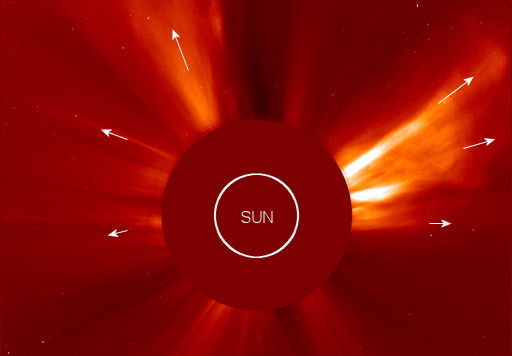Thirty-five new items have just been added to our Meteorite Jewelry collection. Browse the Space Weather Store for something out of this world. | | |
DEC 21st TRANSIT OF VENUS: Today, researchers are using NASA's Cassini spacecraft to observe a rare transit of Venus visible from the planet Saturn. Get the full story from Science@NASA.
WILL THERE BE A DECEMBER 22ND? NASA says yes. The space agency is so sure that the world will not end due to a Mayan Apocalypse on Dec. 21, 2012, that they've already produced a video about the day after: Why the World Didn't End Yesterday
FARSIDE SOLAR ACTIVITY: The Earthside of the sun remains quiet, but the farside is growing restless. During the late hours of Dec. 20th and continuing through Dec. 21st, the Solar and Heliospheric Observatory (SOHO) has recorded a series of CMEs flying over the solar limb:

The source of the clouds appears to be multiple blast sites on the farside of the sun. This means Earth is not in the line of fire. The increasing pace of farside activity, however, suggests that the Earthside might not be far behind. Stay tuned for changes. Solar flare alerts: text, voice.
Realtime Space Weather Photo Gallery
SIX MONTHS IN A SODA CAN: "Winter solstice is coming!" says Rijk-Jan Koppejan of the Philippus Lansbergen Observatory in Middelburg, the Netherlands. To celebrate, patrons of the observatory have started opening their solargraphs, which they deployed six months ago to record the motion of the sun. "This image with the typical Dutch windmill was made by the Sengers family," says Koppejan:

A solargraph is a simple pinhole camera made from a soda can lined with a piece of photographic paper. "Last June, the Philippus Lansbergen Observatory invited people to hang up solargraphs around the province of Zeeland," he explains. "They have recorded the daily path of the sun since the summer solstice."
In a typical six-month solargraph exposure, high arcs track the summer sun, middle arcs the autumn sun, and low arcs the winter sun. The only interruptions are due to clouds and rain. "The weather in Middelburg wasn't too bad after all!"
Most of the solargraphs deployed last June will be opened on Friday the 21st, the northern winter solstice. Stay tuned.
6-month Solargraph How-to Guides: #1, #2, #3
Realtime Aurora Photo Gallery
Realtime Noctilucent Cloud Photo Gallery
[previous years: 2003, 2004, 2005, 2006, 2007, 2008, 2009, 2011]

